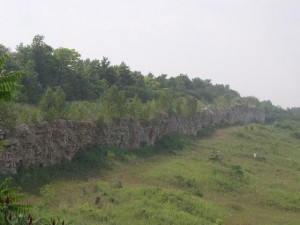Some of my current research centers on the aggregate industry sector, the industry that extracts stone, sand and gravel for construction material. This research is driven by my conviction that this is an under-studied industry sector whose activities need to be scrutinized more closely. This is because aggregates are at the very basis of some of the more hotly debated topics in daily public discourse, such as urban sprawl and climate change. The very holes in the ground left by the industry are testaments to the fuel the industry provides for urban sprawl in the form of tract house subdivisions, public highways and urban infrastructure. Yet the industry is rather obscure, gaining occasional attention when local residents and environmentalists launch campaigns against the establishment of a new or expansion of an old mine, but lacking a systemic and broader critique of the industry as a whole. I have done case study work with students on quarry disputes in the Greater Toronto Area, at Dufferin’s Milton Quarry, and at a proposed quarry by James Dick in Caledon. Both these studies explore the different narratives and discourses that contestants in quarry disputes construct to advance their positions. They are critical of the NIMBY (not in my backyard) character of many of these disputes and argue for a broader perspective. I am also interested in the way the aggregate industry and its environmental and ecological consultants “naturalize” the demand for aggregates and construct and imagine their role as being part of nature, and as nature restorers that can in fact improve on nature parallel to and in the wake of extraction activities.
Sandberg, L. Anders and Lisa Wallace, "'Leave the Sand in the Land, Let the Stone Alone', Pits, Quarries, and Climate Change," ACME: An International E-Journal for Critical Geographies, 12, 1 (2013), 41-57.
Chambers, C. and L. Anders Sandberg, “Pits, Peripheralization and the Politics of Scale: Struggles over Locating Extractive Industries in the Town of Caledon, Ontario, Canada,” Regional Studies, vol. 41, No. 3 (May 2007), 327-38.
Patano, S. and L. Anders Sandberg, “Winning Back More than Words? Power, Discourse and Quarrying on the Niagara Escarpment.” The Canadian Geographer, Vol. 49, No. 1 (March 2005), 25-41.
Sandberg, L. Anders, “The Discourse of Rehabilitated and Constructed Natures: Pit and Quarry Landscapes of the Greater Toronto Area.” Leading Edge 2001 Conference Proceedings. Ontario Ministry of Natural Resources, 2002.
The Quarry Edge at Dufferin Aggregates at Milton, Niagara Escarpment
Click image to enlarge
At Dufferin ’s Milton quarry, the company has maintained the physical edge of the quarry and re-imagined it as a brand new “natural” escarpment. This is referred to as “landscape replication or emulation” where a destroyed or altered landscape form is created or re-created by artificial means. It represents the blurring of boundaries between the massive extraction of aggregate resources and the "natural" geological and ecological processes on the Niagara Escarpment.

